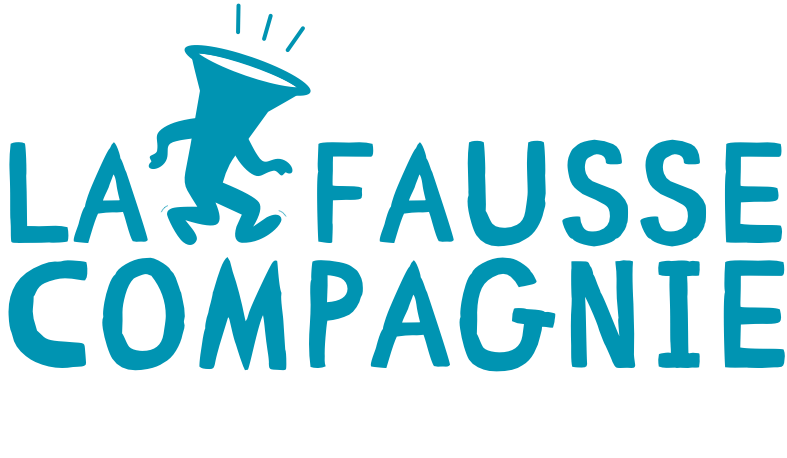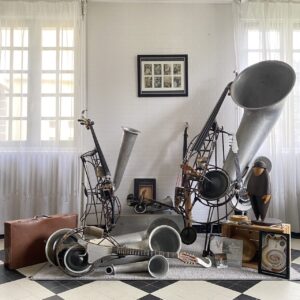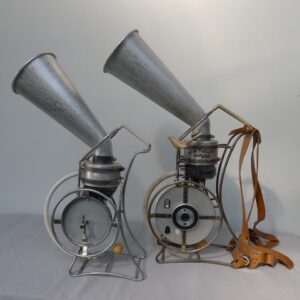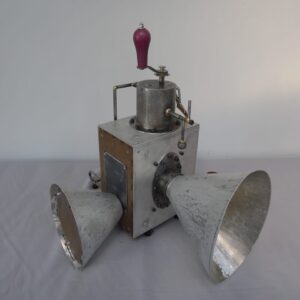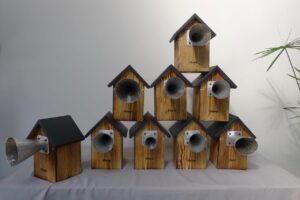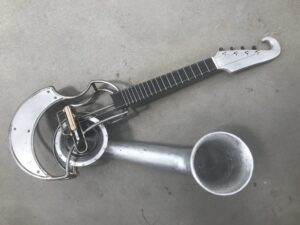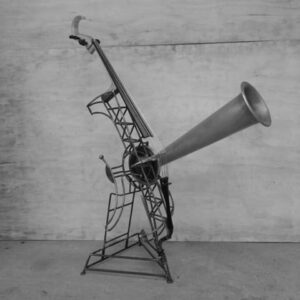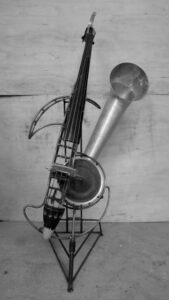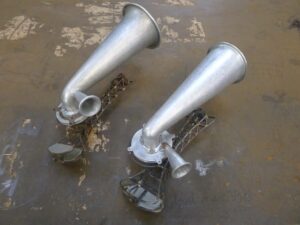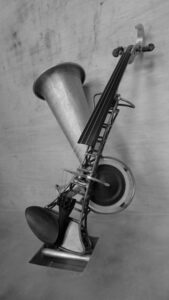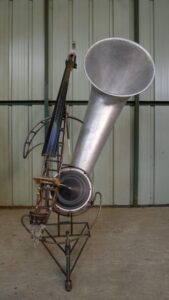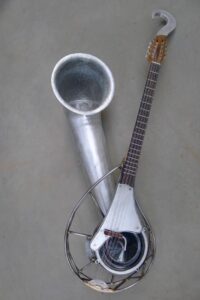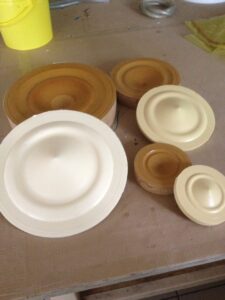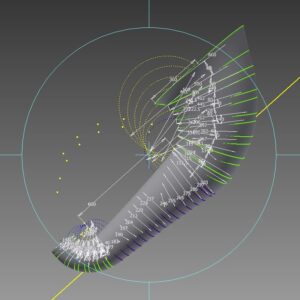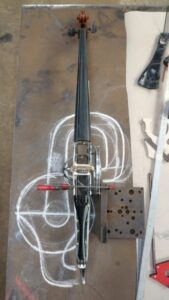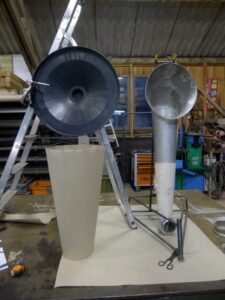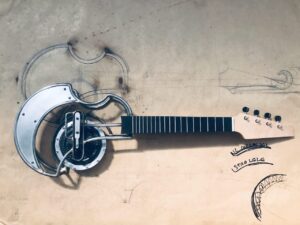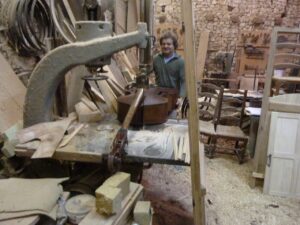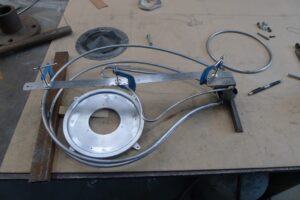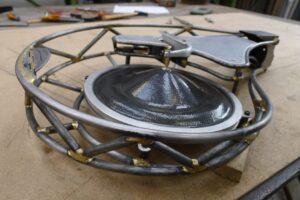Stroh project
The instruments
Kholecteuses 1 et 2
Kolporteur
Nichoirs à chants
Stroh-ukulele
Stroh-cello
Stroh-bass V1
Stroh-violons 1 et 2
Stroh-violon V1
Stroh-bass V2
Stroh-mandole
History and acoustic operation
The invention of the phonograph by T. Edison in 1877 made it possible for the first time to record sound by engraving a groove on a wax cylinder. To work properly, the source (musical instruments, voice, etc.) must have a high sound level. This was not the case with the violin, which was not a very powerful instrument.
In a pragmatic move, the engineer Augustus Stroh, in 1899, proposed a patent that considerably increased the directionality of the violin, enabling it to speak clearly to the recording phonograph.

Drawing of a Stroh violin (extract from patent no. 9418, A.D. 1899. 4 May 1899. A. Stroh, Improvements in violin and other stringed instruments)
A. Stroh proposed far-reaching changes to the classical wooden violin, leading to the birth of the Stroh violin.
- The resonance box was removed and replaced by a rigid body whose sole function was to hold and tune the instrument’s 4 strings.
- The movement of the bridge is modified so that it rotates around an axis parallel to the strings.
- The bridge is connected to a membrane placed at the entrance of an acoustic horn. This pipe, borrowed from the phonograph, ensures that the sound is projected.
- Stroh initially experimented with a flat diaphragm. He made it conical to increase sound power. Stroh’s work inspired the shape of the loudspeaker diaphragms we still know today.

Side view of the swinging bridge (patent no. 9418, A.D. 1899, 4 May 1899. A. Stroh, Improvements in violin and other stringed instruments)
Augustus Stroh, borrowing mechanical amplification techniques from phonographs, designed what he imagined to be the violin of the future. Other patents for violins with horns were registered at the same time.
When acoustic recording was replaced by electric recording in the mid-1920s, the Stroh violin lost its usefulness to the recording world and musicians began recording with their wooden violins.
However, related instruments such as dobro guitars, mandolins, horn basses and the phono fiddle (a one-stringed instrument with a horn) also made their appearance… The Stroh violin was manufactured in London until 1942.

Augustus Stroh
1828-1914
A few stages in the design and manufacture of our instruments
Moule et contre moule pour membrane
Modelisation 3D du pavillon V2 de Strohbass
Fabrication du cello, corps et esquisse pavillon
Pavillon V1 et illustation du pavillon V2 de la Stroh Bass
Stroh-ukulele, corps et esquisse
Découpe de contrebasse
Fabrication du mandole, corps
Fabrication du mandole, membrane
In the course of our research into the Stroh violin, we learned that the Stroh-Bass and the Stroh-cello had existed. We also realised that it would be illusory to try and buy originals, which are too rare and too expensive.
A large number of meetings and exchanges preceded the construction of our first instruments. Sharing information was fundamental to the success of this “rebirth”. Our research for this Stroh reconstruction led us to the Philharmonie de Paris, which owns an original Stroh-cello and Stroh-violin. In 2012, Thierry Maniguet, curator of the museum’s string department, invited us to try out the Stroh-cello and Stroh-violin in the museum’s collection.
Our instruments are prototypes, and we continue to modify them as part of our acoustic experimentation.

Stroh-bass sketch

Stroh-cello sketch
After the first 3 instruments made in 2012 (violin, cello, double bass with horns), we made a second, lighter violin in 2014 and significantly modified the double bass with a new horn, 3 to 4 times larger.
In 2017, we made a mandolin with a pavilion, followed by a ukulele with pavilions in 2022.
The fairground instrumentarium designed by Laurent Cadilhac will also see the birth of some of its cousins, with the Kholporteur, the Kholecteuse and the Phono-Stroh (between 2020 and 2024).
The next instrument to see the light of day will be a pavilion cymbalum (due out in 2026).
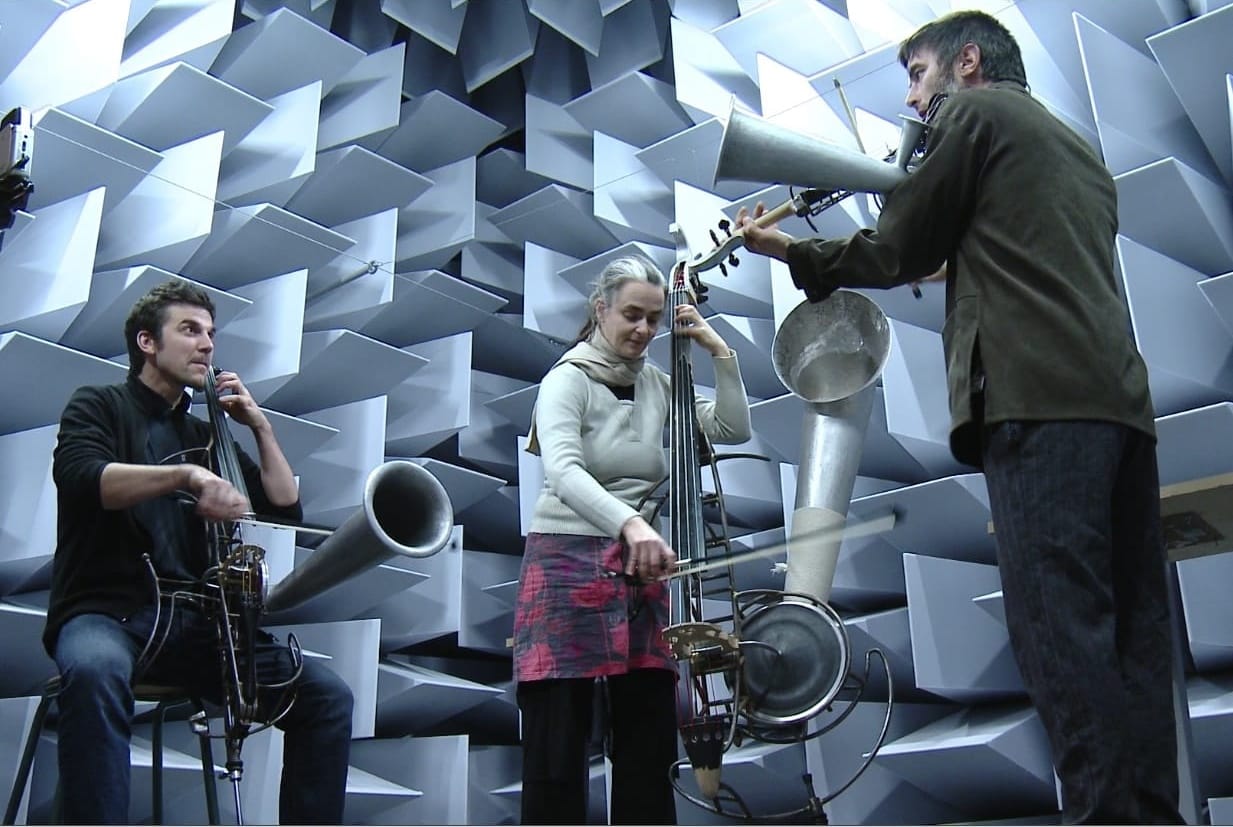
Recording in an anechoic chamber at LAUM (Laboratoire d’Acoustique de l’Université du Mans, 2013)
Acknowledgements
Both in terms of design and production, this atypical violin-making project directly involved a number of people whom we would like to mention and thank here:
Laurent Cadilhac – Metal sculpture
Alain Pignoux – Stringed instruments
Bruno Torrès – Stringed instruments
Robert Kieffer – Acoustic studies and pavilion design
Christophe Boutin – Design and machining of aluminium connectors
Hubert Champigny – Creation of wooden shapes to make resin moulds
Christophe Perin – Producing membranes from composite materials
Paul Collignon – Production of membranes and cases in composite materials
Olavi Linden – Advisor
Philharmonie de Paris – Advisor
François Gautier – Research and advice
Philippe Bureau – Advisor
IUT du Creusot – Manufacture of composite membranes
Eri et Jean-Baptiste Goto-Deberne – Strohbass metrics at the Musashino instrument museum in Tokyo
Laurent Hardy – Aluminium membrane test
Patrick Prud’homme – Neck cutting
© Photos: Laurent Cadilhac, Laure Sornique

